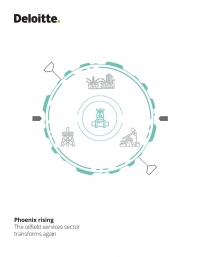Deloitte: Oilfield Services Transformation - Seven strategies for sustainable success - December 2017 - eng (pdf) Избранное
The oilfield services sector transforms again
Seven strategies for sustainable success
After a long downturn, companies in the oilfield services sector are embracing recovery, learning from the past, and looking to seven key strategies for sustainable success.
A damaging downturn
The oilfield services sector in recovery
Deloitte’s new report, Phoenix rising: The oilfield services sector transforms again, examines the impact the downturn has had on the oilfield services sector. It explores the actions and attributes of the companies who survived and prospered during this time, as well as those that did not. With industry recovery taking shape, the paper also discusses the strategies that oilfield services companies are beginning to adopt to improve their performance and resiliency moving forward.
The secrets of survival
To understand the best strategies for moving forward, it is essential to look back. It this case, Deloitte analyzed a group of 56 oilfield services companies to understand why and how they survived the industry downturn. We looked at the common qualities they shared and how could those qualities be used to their advantage—and replicated by other companies—to capitalize on the emerging industry recovery.
The oilfield services companies that were the most resilient during the downturn had more geographically dispersed operations. They also had a greater presence in service segments like offshore operations that benefited from longer-term contracts. Larger services companies—with broader and deeper technological capabilities applicable to diverse operating conditions—were more likely to have these characteristics, although some smaller companies also outperformed the group of examined companies.
Out of the ashes: Seven strategies for sustained recovery
Category 1: Prioritize services that achieve ongoing cost reductions for upstream operators—in particular, those related to achieving business process and integration efficiencies.
Category 2: Reorganize and redesign business processes to reduce internal costs within the services company.
Category 3: Develop new products and services in existing or adjacent markets.
The unifying theme across these strategic categories is the recognition by oilfield services companies that sustainable success will likely depend on meeting and anticipating customer needs.
1 S&P Capital IQ and Deloitte analysis.
Дополнительная информация
- Серия: Консалтинг и научные центры / Deloitte / Oilfield Services Analysis
- Год: 2017
- Месяц: 12 (год)
- Источник: Deloitte


































